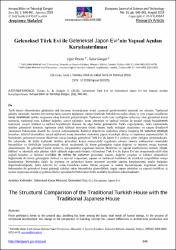| dc.contributor.author | Özcan, Uğur | |
| dc.contributor.author | Güngör, Sena | |
| dc.date.accessioned | 2021-06-09T12:07:08Z | |
| dc.date.available | 2021-06-09T12:07:08Z | |
| dc.date.issued | 2019 | en_US |
| dc.identifier.citation | ÖZCAN, Uğur & Sena GÜNGÖR. "Geleneksel Türk Evi ile Geleneksel Japon Evi’nin Yapısal Açıdan Karşılaştırılması". Avrupa Bilim ve Teknoloji Dergisi, 16 (2019): 646-661. | en_US |
| dc.identifier.uri | https://dergipark.org.tr/tr/download/article-file/769026 | |
| dc.identifier.uri | https://hdl.handle.net/11352/3595 | |
| dc.description.abstract | Tarih öncesi dönemlerden günümüze dek barınma, insanoğlunun temel yaşamsal gereksinimleri arasında yer almıştır. Toplumsal
gelişim sürecinde, barınma kavramına bakış açısının değişmesi, mimari üretimde farklılıklara neden olmuş ve yeni yaşam koşullarına
cevap verebilecek mekân kurgusuna sahip konutlar geliştirilmiştir. Toplumun tarihi kent kimliğinin imleyicisi olan geleneksel konut
mimarisi, toplumsal yapı, kültürel değerler, sosyal eğilimler, inanç sistemleri ve tarihsel birikim ile paralel olarak biçimlenerek
toplumsal, sosyal, kültürel ve tarihsel boyutlarıyla dinamik bir olgu haline gelmektedir. Farklı coğrafyalarda, farklı toplumlarda
üretilen geleneksel konutlar, toplumun ortak kültürel mirasının ürünü olması, tarihi belleğini oluşturması ve yaşam felsefesini
yansıtması bakımından önemli bir misyon üstlenmektedir. Kültürel değerlerini muhafaza etmeyi başarmış iki toplumun ideolojik
tutumları, kültürel dinamikleri, sosyal eğilimleri, inanç sistemleri, ekonomik yapısı, teknolojik düzeyi ve toplumun yaşanmışlıkları ile
biçimlenen, geleneksel tasarım ilkelerinin vücud bulduğu geleneksel Türk Evi ile Japon Evi yüzlerce yıldır varlığını sürdürmektedir.
Bu çalışmada, iki farklı toplumda üretilen geleneksel konut mimarisinde uygulanan mimari tasarım yaklaşımları arasındaki
benzerlikler ve farklılıklar karşılaştırmalı olarak incelenerek iki konut geleneğinin özgün değerini ve önemini ortaya koymak
amaçlanmıştır. İki geleneksel konut mimarisi, oluşumundan uygulanan tasarım ilkelerinin ve yapısal özelliklerinin tarihsel, sosyal,
kültürel ve ideolojik arka planları tahlil edilerek değerlendirilmiştir. Geleneksel Türk Evi ile Japon Evi’nin oluşumunda etkili olan
coğrafi koşullar ve iklimsel özellikler ile birlikte iki toplumun geleneksel yaşamı, değerler yargıları ve kültürel dinamikleri
bağlamında iki konut geleneğinin fiziksel ve işlevsel oluşumları, yapısal ve mekânsal özellikleri ile estetiksel zenginlikleri ortaya
konulmuştur. Birbirinden farklı iki topluma ait geleneksel konut mimarisi arasında yapılan karşılaştırmalı analiz bulguları
değerlendirildiğinde, farklı işlevleri bir arada barındıran esnek mekân kurgusu, iç mekân biçimlenişinde uygulanan detaylar
bakımından iki geleneksel konut geleneği oldukça yakın benzerlikler gösterdikleri, özgün yapım teknikleri ve yapısal özellikler, iç
mekan organizasyonunda uygulanan ilkeler açısından birbirlerinden farklı nitelikler taşıdıkları anlaşılmaktadır. | en_US |
| dc.description.abstract | From prehistoric times to the present day, dwelling has been among the basic vital needs of human beings. In the process of
communal development, the change in the perspective of dwelling concept has caused differences in architectural production and houses was developed which could meet the new living conditions. The traditional dwelling architecture which is the marker of the
urban identity, is shaped in parallel with the social structure, cultural values, social tendencies, belief systems and historical
accumulation, becomes a dynamic phenomenon with its communal, social, cultural and historical dimensions. The traditional houses
produced in different geographies and different societies undertake an important mission in terms of being the product of the common
cultural heritage of the society, forming the historical memory and reflecting the philosophy of lifestyle. The traditional Turkish
House and Japanese House, which is shaped by the ideological attitudes, cultural dynamics, social tendencies, belief systems,
economic structure, technological level and the experience of the society, has been in existence for hundreds of years. In this study,
the similarities and differences between the architectural design approaches applied in traditional dwelling architectures, which are
produced in two different communities, were examined comparatively and it was aimed to reveal the original value and importance of
the two dwelling traditions. Two traditional dwelling architecture have been evaluated by analyzing the historical, social, cultural and
ideological backgrounds of design principles and structural features applied in their formation. The geographical conditions and
climatic features with the physical and functional formations, structural and spatial features and aesthetic richness that influenced the
formation of the traditional Turkish House and the Japanese House were revealed in the context of the traditional life, values
judgments and cultural dynamics. When the findings of the comparative analysis between two traditional dwelling architectures are
evaluated, it is understood that the two dwelling traditions show similarities in terms of the flexible spatial configuration and the
interior design details and differences in terms of the principles applied in the interior organization, construction techniques and
structural features. | en_US |
| dc.language.iso | tur | en_US |
| dc.publisher | EJOSAT | en_US |
| dc.relation.isversionof | 10.31590/ejosat.591305 | en_US |
| dc.rights | info:eu-repo/semantics/openAccess | en_US |
| dc.subject | Geleneksel Konut Mimarisi | en_US |
| dc.subject | Geleneksel Türk Evi | en_US |
| dc.subject | Geleneksel Japon Evi | en_US |
| dc.subject | Traditional Dwelling Architecture | en_US |
| dc.subject | Traditional Turkish House | en_US |
| dc.subject | Traditional Japanese House | en_US |
| dc.title | Geleneksel Türk Evi ile Geleneksel Japon Evi’nin Yapısal Açıdan Karşılaştırılması | en_US |
| dc.title.alternative | The Structural Comparison of the Traditional Turkish House with the Traditional Japanese House | en_US |
| dc.type | article | en_US |
| dc.relation.journal | Avrupa Bilim ve Teknoloji Dergisi | en_US |
| dc.contributor.department | FSM Vakıf Üniversitesi, Mimarlık ve Tasarım Fakültesi, Mimarlık Bölümü | en_US |
| dc.contributor.authorID | https://orcid.org/0000-0003-0002-4478 | en_US |
| dc.contributor.authorID | https://orcid.org/0000-0002-1124-2385 | en_US |
| dc.identifier.issue | 16 | en_US |
| dc.identifier.startpage | 646 | en_US |
| dc.identifier.endpage | 661 | en_US |
| dc.relation.publicationcategory | Makale - Uluslararası Hakemli Dergi - Kurum Öğretim Elemanı | en_US |
| dc.contributor.institutionauthor | Özcan, Uğur | |
| dc.contributor.institutionauthor | Güngör, Sena | |



















